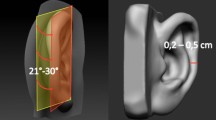Abstract
Background
Mirror ear, also known as polyotia, is an infrequently reported form of external ear malformation characterized by morphologic and dimensional similarity to a normal pinna. The condition has been described in association with various syndromes, and in isolation. However, as the data with specific relevance to polyotia is sparse, not only are the precise causative processes of mirror ear unknown, but the paucity of documented cases also lends the operative approach to be daunting.
Methods
Six patients with eight mirror ears underwent surgical reconstruction at Great Ormond Street Hospital for Children. All children were followed from infancy and reviewed in a multidisciplinary setting to coordinate aspects of their care—including plastic surgery, maxillofacial surgery, dentistry, audiology, speech and language pathology, and psychiatry where relevant. Concurrent surgical procedures in addition to mirror ear correction occurred in four patients.
Results
Pleasing results were achieved in all cases, as reconstruction employed a bespoke approach. Nonetheless, there were unifying principles adhered to, which began in the planning stages by assessing the morphology of the anomalous ear and evaluating the accessory cartilage available for utilization. Deliberate positioning of the incisions, exploiting cartilage remnants to fill the depression of the mirrored ear, and manipulation of excess tissue to reconstruct an anatomically sound tragus were crucial to achieving agreeable aesthetic results.
Conclusions
Given that it is rarely encountered, the successful reconstruction of a mirrored ear requires a thoughtful surgical approach. With this report, we provide a comprehensive review of this unique type of ear deformity, significantly add to the documented cases of polyotia, and describe our operative technique to recreate a tragus that throws a natural shadow in the conchal bowl and shields the external auditory meatus.
Level of evidence: level V, therapeutic study.


Similar content being viewed by others
References
Karmody CS, Annino DJ Jr (1995) Embryology and anomalies of the external ear. Facial Plast Surg 11(4):251–256
Ku PK, Tong MC, Yue V (1998) Polyotia—a rare external ear anomaly. Int J Pediatr Otorhinolaryngol 46(1–2):117–120
Farhadieh RD, Bulstrode N, Cugno S (2015) Plastic and reconstructive surgery: approach and techniques. John Wiley & Sons Inc., Chichester, West Sussex; Hoboken, NJ, pp 238–254
von Bol G, de Kleyn A (1918) Über eine fall von polyotie. Acta Otolaryngol 1:187–188
Jansen T, Romiti R, Altmeyer P (2000) Accessory tragus: report of two cases and review of the literature. Pediatr Dermatol 17(5):391–394
Arey LB (1974) Developmental anatomy: a textbook and laboratory manual of embryology. Rev. 7th edn. W. B. Saunders, Philadelphia, pp 541–550
Porter CJ, Tan ST (2005) Congenital auricular anomalies: topographic anatomy, embryology, classification, and treatment strategies. Plast Reconstr Surg 115(6):1701–1712
Yang Y, Guo J, Liu Z, Tang S, Li N, Yang M, Pang Q, Fan F, Bu J, Yuan ST, Xiao X, Chen Y, Zhao K (2006) A locus for autosomal dominant accessory auricular anomaly maps to 14q11.2-q12. Hum Genet 120(1):144–147
Gore SM, Myers SR, Gault D (2006) Mirror ear: a reconstructive technique for substantial tragal anomalies or polyotia. J Plast Reconstr Aesthet Surg 59(5):499–504
Pan B, Qie S, Zhao Y, Tang X, Lin L, Yang Q, Zhuang H, Jiang H (2010) Surgical management of polyotia. J Plast Reconstr Aesthet Surg 63(8):1283–1288
Conflict of interest
Whitney L. Quong and Neil W. Bulstrode declare that they have no conflict of interest.
Ethical standards
For this type of retrospective study, formal consent from an ethics committee is not required.
Patient consent
Parents or legal guardians provided written consent for the use of patients' images.
Author information
Authors and Affiliations
Corresponding author
Rights and permissions
About this article
Cite this article
Quong, W.L., Bulstrode, N.W. Mirror ear—surgical correction of this rare external ear anomaly: A case series. Eur J Plast Surg 38, 285–290 (2015). https://doi.org/10.1007/s00238-015-1087-0
Received:
Accepted:
Published:
Issue Date:
DOI: https://doi.org/10.1007/s00238-015-1087-0




